Hoang Nguyen
Investigation of Using Non-Contact Electrodes for Fetal ECG Monitoring
Oct 01, 2025



Abstract:Regular physiological monitoring of maternal and fetal parameters is indispensable for ensuring safe outcomes during pregnancy and parturition. Fetal electrocardiogram (fECG) assessment is crucial to detect fetal distress and developmental anomalies. Given challenges of prenatal care due to the lack of medical professionals and the limit of accessibility, especially in remote and resource-poor areas, we develop a fECG monitoring system using novel non-contact electrodes (NCE) to record the fetal/maternal ECG (f/mECG) signals through clothes, thereby improving the comfort during measurement. The system is designed to be incorporated inside a maternity belt with data acquisition, data transmission module as well as novel NCEs. Thorough characterizations were carried out to evaluate the novel NCE against traditional wet electrodes (i.e., Ag/AgCl electrodes), showing comparable performance. A successful {preliminary pilot feasibility study} conducted with pregnant women (n = 10) between 25 and 32 weeks of gestation demonstrates the system's performance, usability and safety.
AU-Harness: An Open-Source Toolkit for Holistic Evaluation of Audio LLMs
Sep 11, 2025Abstract:Large Audio Language Models (LALMs) are rapidly advancing, but evaluating them remains challenging due to inefficient toolkits that limit fair comparison and systematic assessment. Current frameworks suffer from three critical issues: slow processing that bottlenecks large-scale studies, inconsistent prompting that hurts reproducibility, and narrow task coverage that misses important audio reasoning capabilities. We introduce AU-Harness, an efficient and comprehensive evaluation framework for LALMs. Our system achieves a speedup of up to 127% over existing toolkits through optimized batch processing and parallel execution, enabling large-scale evaluations previously impractical. We provide standardized prompting protocols and flexible configurations for fair model comparison across diverse scenarios. Additionally, we introduce two new evaluation categories: LLM-Adaptive Diarization for temporal audio understanding and Spoken Language Reasoning for complex audio-based cognitive tasks. Through evaluation across 380+ tasks, we reveal significant gaps in current LALMs, particularly in temporal understanding and complex spoken language reasoning tasks. Our findings also highlight a lack of standardization in instruction modality existent across audio benchmarks, which can lead up performance differences up to 9.5 absolute points on the challenging complex instruction following downstream tasks. AU-Harness provides both practical evaluation tools and insights into model limitations, advancing systematic LALM development.
LALM-Eval: An Open-Source Toolkit for Holistic Evaluation of Large Audio Language Models
Sep 09, 2025Abstract:Large Audio Language Models (LALMs) are rapidly advancing, but evaluating them remains challenging due to inefficient toolkits that limit fair comparison and systematic assessment. Current frameworks suffer from three critical issues: slow processing that bottlenecks large-scale studies, inconsistent prompting that hurts reproducibility, and narrow task coverage that misses important audio reasoning capabilities. We introduce LALM-Eval, an efficient and comprehensive evaluation framework for LALMs. Our system achieves a speedup of up to 127% over existing toolkits through optimized batch processing and parallel execution, enabling large-scale evaluations previously impractical. We provide standardized prompting protocols and flexible configurations for fair model comparison across diverse scenarios. Additionally, we introduce two new evaluation categories: LLM-Adaptive Diarization for temporal audio understanding and Spoken Language Reasoning for complex audio-based cognitive tasks. Through evaluation across 380+ tasks, we reveal significant gaps in current LALMs, particularly in temporal understanding and complex spoken language reasoning tasks. Our findings also highlight a lack of standardization in instruction modality existent across audio benchmarks, which can lead up performance differences up to 9.5 absolute points on the challenging complex instruction following downstream tasks. LALM-Eval provides both practical evaluation tools and insights into model limitations, advancing systematic LALM development.
A Survey on Large Language Model based Human-Agent Systems
May 01, 2025Abstract:Recent advances in large language models (LLMs) have sparked growing interest in building fully autonomous agents. However, fully autonomous LLM-based agents still face significant challenges, including limited reliability due to hallucinations, difficulty in handling complex tasks, and substantial safety and ethical risks, all of which limit their feasibility and trustworthiness in real-world applications. To overcome these limitations, LLM-based human-agent systems (LLM-HAS) incorporate human-provided information, feedback, or control into the agent system to enhance system performance, reliability and safety. This paper provides the first comprehensive and structured survey of LLM-HAS. It clarifies fundamental concepts, systematically presents core components shaping these systems, including environment & profiling, human feedback, interaction types, orchestration and communication, explores emerging applications, and discusses unique challenges and opportunities. By consolidating current knowledge and offering a structured overview, we aim to foster further research and innovation in this rapidly evolving interdisciplinary field. Paper lists and resources are available at https://github.com/HenryPengZou/Awesome-LLM-Based-Human-Agent-System-Papers.
Gold-medalist Performance in Solving Olympiad Geometry with AlphaGeometry2
Feb 05, 2025Abstract:We present AlphaGeometry2, a significantly improved version of AlphaGeometry introduced in Trinh et al. (2024), which has now surpassed an average gold medalist in solving Olympiad geometry problems. To achieve this, we first extend the original AlphaGeometry language to tackle harder problems involving movements of objects, and problems containing linear equations of angles, ratios, and distances. This, together with other additions, has markedly improved the coverage rate of the AlphaGeometry language on International Math Olympiads (IMO) 2000-2024 geometry problems from 66% to 88%. The search process of AlphaGeometry2 has also been greatly improved through the use of Gemini architecture for better language modeling, and a novel knowledge-sharing mechanism that combines multiple search trees. Together with further enhancements to the symbolic engine and synthetic data generation, we have significantly boosted the overall solving rate of AlphaGeometry2 to 84% for $\textit{all}$ geometry problems over the last 25 years, compared to 54% previously. AlphaGeometry2 was also part of the system that achieved silver-medal standard at IMO 2024 https://dpmd.ai/imo-silver. Last but not least, we report progress towards using AlphaGeometry2 as a part of a fully automated system that reliably solves geometry problems directly from natural language input.
AdaCS: Adaptive Normalization for Enhanced Code-Switching ASR
Jan 13, 2025

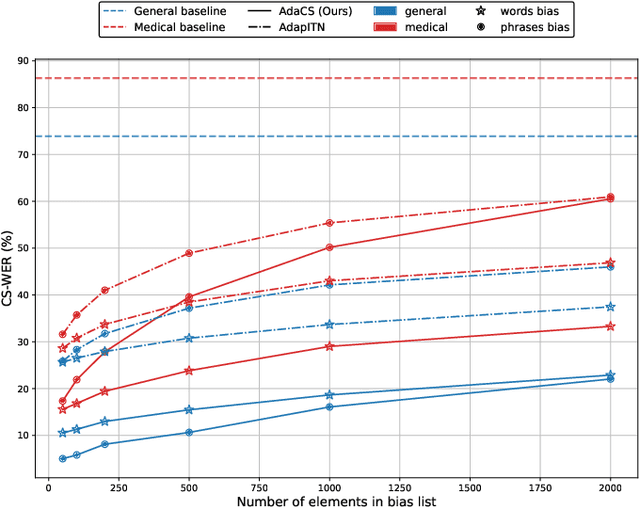
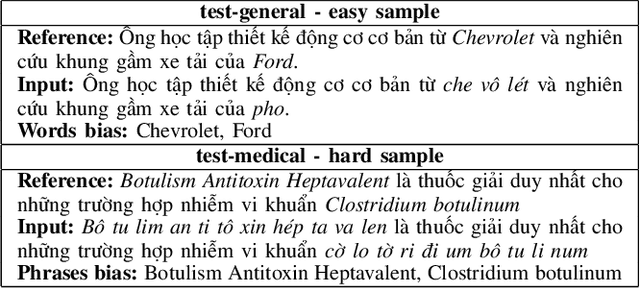
Abstract:Intra-sentential code-switching (CS) refers to the alternation between languages that happens within a single utterance and is a significant challenge for Automatic Speech Recognition (ASR) systems. For example, when a Vietnamese speaker uses foreign proper names or specialized terms within their speech. ASR systems often struggle to accurately transcribe intra-sentential CS due to their training on monolingual data and the unpredictable nature of CS. This issue is even more pronounced for low-resource languages, where limited data availability hinders the development of robust models. In this study, we propose AdaCS, a normalization model integrates an adaptive bias attention module (BAM) into encoder-decoder network. This novel approach provides a robust solution to CS ASR in unseen domains, thereby significantly enhancing our contribution to the field. By utilizing BAM to both identify and normalize CS phrases, AdaCS enhances its adaptive capabilities with a biased list of words provided during inference. Our method demonstrates impressive performance and the ability to handle unseen CS phrases across various domains. Experiments show that AdaCS outperforms previous state-of-the-art method on Vietnamese CS ASR normalization by considerable WER reduction of 56.2% and 36.8% on the two proposed test sets.
Prompting with Phonemes: Enhancing LLM Multilinguality for non-Latin Script Languages
Nov 04, 2024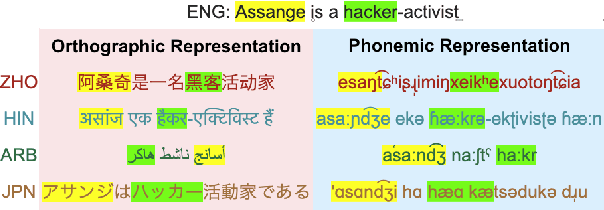

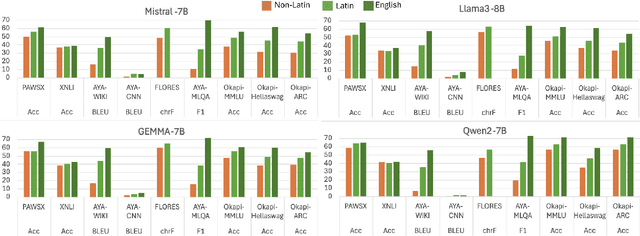

Abstract:Multilingual LLMs have achieved remarkable benchmark performance, but we find they continue to underperform on non-Latin script languages across contemporary LLM families. This discrepancy arises from the fact that LLMs are pretrained with orthographic scripts, which are dominated by Latin characters that obscure their shared phonology with non-Latin scripts. We propose leveraging phonemic transcriptions as complementary signals to induce script-invariant representations. Our study demonstrates that integrating phonemic signals improves performance across both non-Latin and Latin languages, with a particularly significant impact on closing the performance gap between the two. Through detailed experiments, we show that phonemic and orthographic scripts retrieve distinct examples for in-context learning (ICL). This motivates our proposed Mixed-ICL retrieval strategy, where further aggregation leads to our significant performance improvements for both Latin script languages (up to 12.6%) and non-Latin script languages (up to 15.1%) compared to randomized ICL retrieval.
M2Lingual: Enhancing Multilingual, Multi-Turn Instruction Alignment in Large Language Models
Jun 24, 2024



Abstract:Instruction finetuning (IFT) is critical for aligning Large Language Models (LLMs) to follow instructions. Numerous effective IFT datasets have been proposed in the recent past, but most focus on high resource languages such as English. In this work, we propose a fully synthetic, novel taxonomy (Evol) guided Multilingual, Multi-turn instruction finetuning dataset, called M2Lingual, to better align LLMs on a diverse set of languages and tasks. M2Lingual contains a total of 182K IFT pairs that are built upon diverse seeds, covering 70 languages, 17 NLP tasks and general instruction-response pairs. LLMs finetuned with M2Lingual substantially outperform the majority of existing multilingual IFT datasets. Importantly, LLMs trained with M2Lingual consistently achieve competitive results across a wide variety of evaluation benchmarks compared to existing multilingual IFT datasets. Specifically, LLMs finetuned with M2Lingual achieve strong performance on our translated multilingual, multi-turn evaluation benchmark as well as a wide variety of multilingual tasks. Thus we contribute, and the 2 step Evol taxonomy used for its creation. M2Lingual repository - https://huggingface.co/datasets/ServiceNow-AI/M2Lingual
ConPro: Learning Severity Representation for Medical Images using Contrastive Learning and Preference Optimization
Apr 29, 2024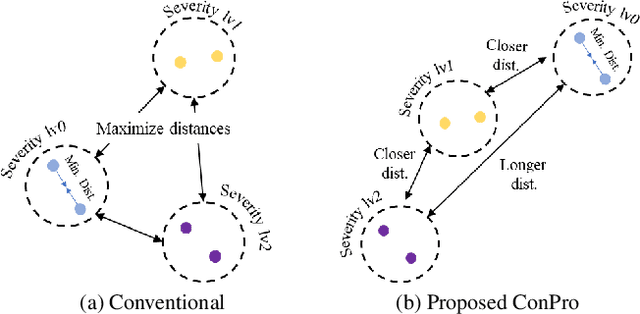



Abstract:Understanding the severity of conditions shown in images in medical diagnosis is crucial, serving as a key guide for clinical assessment, treatment, as well as evaluating longitudinal progression. This paper proposes Con- PrO: a novel representation learning method for severity assessment in medical images using Contrastive learningintegrated Preference Optimization. Different from conventional contrastive learning methods that maximize the distance between classes, ConPrO injects into the latent vector the distance preference knowledge between various severity classes and the normal class. We systematically examine the key components of our framework to illuminate how contrastive prediction tasks acquire valuable representations. We show that our representation learning framework offers valuable severity ordering in the feature space while outperforming previous state-of-the-art methods on classification tasks. We achieve a 6% and 20% relative improvement compared to a supervised and a self-supervised baseline, respectively. In addition, we derived discussions on severity indicators and related applications of preference comparison in the medical domain.
LVM-Med: Learning Large-Scale Self-Supervised Vision Models for Medical Imaging via Second-order Graph Matching
Jul 09, 2023



Abstract:Obtaining large pre-trained models that can be fine-tuned to new tasks with limited annotated samples has remained an open challenge for medical imaging data. While pre-trained deep networks on ImageNet and vision-language foundation models trained on web-scale data are prevailing approaches, their effectiveness on medical tasks is limited due to the significant domain shift between natural and medical images. To bridge this gap, we introduce LVM-Med, the first family of deep networks trained on large-scale medical datasets. We have collected approximately 1.3 million medical images from 55 publicly available datasets, covering a large number of organs and modalities such as CT, MRI, X-ray, and Ultrasound. We benchmark several state-of-the-art self-supervised algorithms on this dataset and propose a novel self-supervised contrastive learning algorithm using a graph-matching formulation. The proposed approach makes three contributions: (i) it integrates prior pair-wise image similarity metrics based on local and global information; (ii) it captures the structural constraints of feature embeddings through a loss function constructed via a combinatorial graph-matching objective; and (iii) it can be trained efficiently end-to-end using modern gradient-estimation techniques for black-box solvers. We thoroughly evaluate the proposed LVM-Med on 15 downstream medical tasks ranging from segmentation and classification to object detection, and both for the in and out-of-distribution settings. LVM-Med empirically outperforms a number of state-of-the-art supervised, self-supervised, and foundation models. For challenging tasks such as Brain Tumor Classification or Diabetic Retinopathy Grading, LVM-Med improves previous vision-language models trained on 1 billion masks by 6-7% while using only a ResNet-50.
 Add to Chrome
Add to Chrome Add to Firefox
Add to Firefox Add to Edge
Add to Edge